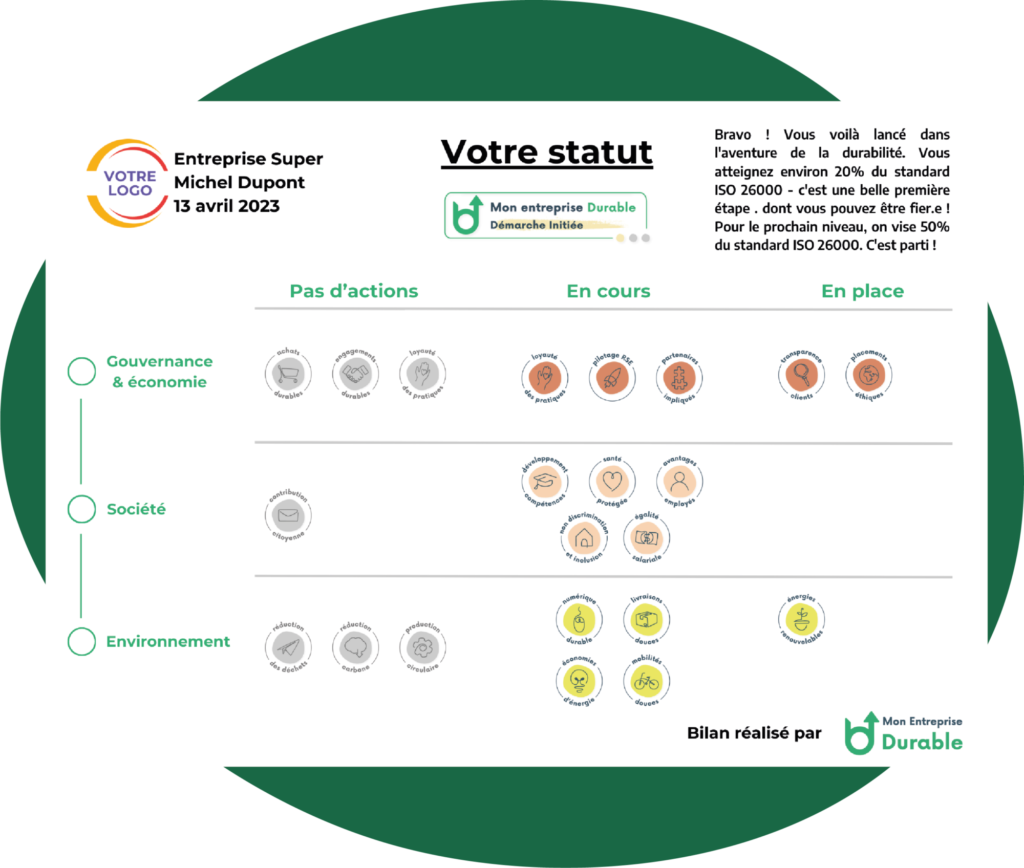Discover the essential steps for an effective csr approach!
CSR stands for corporate social responsibility.
It refers to all the practices a company can put in place to meet sustainable development objectives.
Key points of the article
Businesses are part of our ecosystem.
They produce goods and services, play an active role in the economies of countries and territories, employ people and maintain partnerships with each other, but they also emit greenhouse gases and waste.
As an integral part of society, companies have a role to play not only in the well-being of their workers, but also in terms of environmental impact, the reduction of inequalities, access to employment and the development of territories.
The UN’s sustainable development goals cannot be achieved without them.
These objectives are structured around 5 pillars: environment, social, economy, governance and territory.
This is the primary aim of CSR: to encourage participation and increase the contribution of companies to achieving the 17 goals set by the UN.
What is ISO 26000?
The official definition of ISO 26000 is “an organization’s responsibility for the impact of its decisions and activities on society and the environment through ethical and transparent behavior”.
This standard was published in 2010 and developed by experts.
The aim of the standard is to provide guidelines for companies wishing to commit to CSR.
It sets out 7 core elements: respect for human rights, working conditions, the environment, fair practices, respect for consumers and local development.
It can help companies take an effective and useful approach in all areas.
It has been designed to be relevant to all types of companies and associations.
This standard does not lead to certification, but many others do!
Seeking certification enables you to set precise objectives and, above all, to prove to your employees and customers that you are indeed committed to a CSR approach and that you have achieved results.
In fact, some labels are based on the ISO 26000 standard to assess a company’s CSR approach.
When you obtain certification, you receive an attestation of your CSR approach, reinforcing the credibility of your actions.
Why implement a CSR approach?
There are many arguments in favor of a CSR approach.
This approach is beneficial for a company, not only for its internal operations, but also for its attractiveness and the well-being of the society in which it operates.
Firstly, French employees often expect a CSR approach and more commitment from their company on environmental and social issues in particular.
In a 2016 survey published by Cone Communication, 58% of respondents said that the implementation of a CSR approach was an important criterion when choosing a job.
And, 51% said they would not want to work for a company that was not socially or environmentally committed.
This approach enables companies to build employee loyalty and enhance team spirit and a sense of belonging.
It also enhances the company’s attractiveness for recruitment, as well as for customers and potential partners.
Identifying the impact of your activities on the environment and society helps you work towards making them positive.
What’s more, it helps raise awareness among your employees.
Thanks to the CSR approach, you can make a positive impact on the environment and on the region in which you operate.
You can also see it as an opportunity to evaluate your company’s production methods.
You can derive financial benefits and enhance your image as a brand.
How do you deploy a CSR approach?
A CSR approach can be implemented in any business sector.
Hotels, consulting firms, restaurants, insurance companies, real estate agencies – all companies can implement a CSR approach.
At present, 50% of SMEs have implemented a CSR approach according to a 2017 survey by bpi France.
However, only half of them have established a structured approach.
To ensure the success of your CSR project, we recommend that you follow a number of steps.
These steps will help you build a project that is viable and sustainable over the long term.
Once your CSR approach is in place, it’s important to communicate on your actions and, above all, to monitor your performance.
Step 1: What is your goal?
The first step is to set clear objectives.
You need to define your priorities.
For example, do you want to improve the well-being of your employees above all else?
Do you want to limit your greenhouse gas emissions?
Do you want to contribute to the economic development of your region?
Once you’ve listed your objectives, you’ll need to decide who will be involved in the project.
You can involve your employees, suppliers, contractors and partners, and even your customers.
It’s best to involve all your employees and communicate with everyone you interact with.
You can start with a few employees and then expand your approach as you go along.
At this stage, you can take the opportunity to ask your employees about their expectations and ideas in relation to this CSR policy.
According to a 2020 study on employees and responsible companies carried out by the Occurrence polling institute, Des enjeux et des Hommes and Ekodev, 70% of workers want to get more involved in CSR, and 75% want to put forward ideas.
Yet they are involved in only 21% of cases.
Next, you need to decide who is going to lead this process.
You can call on a consultant or specialized consultancy outside your company, or recruit internally.
In all cases, you need an internal CSR referent to monitor the process and ensure its feasibility.
Step 2: Preparing the ground
The second step is to gather the information you need to draw up your action plan.
To do this, you can take stock of all your activities as a company.
This includes everything from purchasing and production methods to waste management and employee travel.
Ideally, everything is taken into account.
You can also find out about the CSR initiatives of your partner companies.
With this information, you can carry out a diagnosis (audit) of your current performance.
This audit can be carried out in-house or by a specialized firm.
This study must be detailed.
Its aim is to enable you to identify the actions that will help you achieve your objectives.
The inventory of your activities and the audit should enable you to identify all your environmental, social and societal impacts, and make it easier to identify areas for improvement.
Your objectives must be adapted to your current performance.
The audit also enables you to assess your financial, human and material resources.
Current performance needs to be assessed both internally and externally.
Obviously, you need to ensure your economic sustainability.
You can also focus on social performance, by assessing your organization, the skills of your employees and your reputation, for example.
On the environmental side, you can measure your impact on biodiversity, your greenhouse gas emissions or your consumption habits.
Step 3: Set precise objectives
With the results of the audit, you can establish quantified objectives.
This will give you a better chance of achieving them.
For example, if you’ve estimated that 14% of the waste generated by your company is recycled, you can set yourself a target of 50% by the end of the year.
Similarly, if you want to make a commitment to your local area, you can set a percentage of local partners with whom you work.
Step 4: Draw up a schedule
To keep your commitments, there’s nothing better than drawing up a precise schedule with deadlines and regular performance monitoring.
We recommend putting your commitments on paper and communicating them.
Internally, you can draw up a document summarizing your CSR policy and distribute it.
It will also help to ensure that your employees actively participate in the success of your approach, especially if you are implementing a new purchasing or mobility policy, for example.
Step 5: Prepare your teams
Once the objectives and deadlines have been set, you need to prepare your teams for these changes.
Your employees must understand the importance of implementing this CSR policy and contribute to it.
You can do this by raising awareness and providing training.
There is a wide range of CSR training courses available, both on the approach itself and on the roles you need to play.
For example, you can train your managers in CSR and sustainable management.
Step 6: Now it's time to take action!
You now have your objectives, your schedule and your teams ready.
Now it’s time to take action.
You need to think through and implement concrete measures to achieve your goals.
Depending on your objectives, there are several ways to take action.
For example, you can review the way you produce, work with new suppliers who are more local and/or more respectful of the environment or their workers, you can use new materials…
More concretely, if you want to limit your carbon footprint, you can reduce your energy costs.
To do so, you can ensure that your buildings are well insulated, install solar panels on roofs, use low-energy light bulbs, regulate the use of air conditioning and heating, and monitor the energy performance of appliances….
You can also implement a mobility policy to reduce your greenhouse gas emissions.
In fact, since January 1, 2018, companies based in France have been obliged to specify a mobility plan.
Several solutions are available to you: you can favor telecommuting and videoconferencing, public transport with the assumption of subscriptions, you can encourage carpooling and the use of bicycles.
You can also change your fleet of internal combustion vehicles for electric ones, and install a recharging station close to your workplace.
Your CSR can enable you to participate in the circular economy.
This virtuous cycle encourages local, short-distance supply chains, and often reduces costs for the entire chain.
On the societal side, you can ensure equal pay for men and women, and equal access to all positions.
Hiring a diversity and inclusion officer can help.
In the same way, you can promote access to employment for young people: internships, work-study programs, first hires after graduation, etc.
Step 7: Monitor your performance
This is perhaps the most important step in making your CSR approach a success: you need to monitor your performance and progress on a regular basis.
In certain situations, you may need to revise your objectives upwards or downwards, but also set new ones once they have been achieved.
To do this, we recommend that you set up monitoring indicators.
You need to be transparent with your employees and customers about your CSR approach, your objectives, your failures and your areas for improvement.
You can communicate your results both internally and to your customers!




